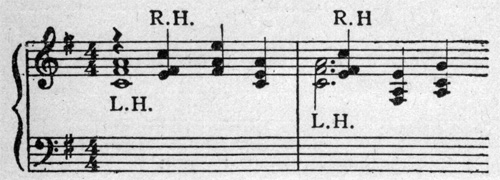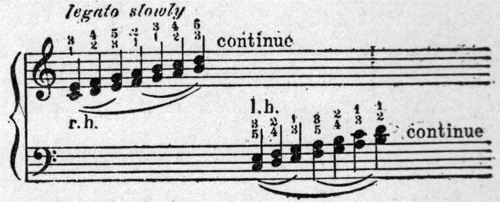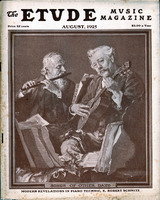Conducted by Arthur de Guichard
The Damper Pedal.
Q. Should the damper, or loud, pedal be used when playing the compositions of the ancient masters, many of whom lived before the invention of the pianoforte?—Dorothy P., Pawtucket, R. I.
A. “Damper” is the correct name; “loud” is a misnomer; some of the most beautiful soft effects are produced by the use of the damper pedal. This question applies to all the compositions for spinet, harpsichord, clavichord, clavecin, and so on, up to the time of Carl Phillip Emanuel Bach, the talented son of the great Johannes Sebastian Bach. All compositions for any of these instruments may be enhanced by a judicious use of the damper pedal—even the works of the great J. S. Bach himself; but it must be used in such a way that the harmonies are not confused and that the beauties of the intermingling melodies be not obscured.
The Meaning of Sino.
Q. Should the first chord in each measure be taken with the left-hand ? What is the meaning of “sino?”—E. P. Winchester, O.
 Nationality of Frederick Delius.
Nationality of Frederick Delius.
Q. Will you kindly tell me the nationality of Frederick Delius? I have been told that he is American, English, French, German (!), by so many different persons that I would like to have some good authority for stating what he really is.—Edith Zarling, Cambridge, Mass.
A. Frederick Delius is English from the place of his birth, having been born at Bradford, England; but he is of German origin. After studying some time alone, he went to Florida (U. S. A.), where he remained two years. He then went to Leipsig where he studied under Jadassohn and Reinecke. He has lived for a long time in France; indeed, he has dwelt but very little in his native country. Nevertheless, he is usually looked upon as an Englishman, his compositions for the most part bearing English names.
Music from Jamaica.
Q. Has Jamaica contributed in any way to the growth of Musical Art? Have any well-known musicians been born there?— Roland P., New Bedford, Mass.
A. Frederick Hymen Cowen, composer, for many years conductor of the late Queen Victoria’s private orchestra, was born at Kingston, Jamaica. He studied music with Moscheles, Plaidy, Reinecke, Richter, Hauptmann and others at Leipsig. He has written six symphonies, four operas, oratorios and cantatas, some chamber-music and a few operettas. Although not born in Jamaica, William Dauney may be considered as a son of the island, his father, William Dauney, having belonged to Falmouth, Jamaica. The son’s contribution to music consists chiefly of literary works bearing upon the history of Scotch music. Dauney, the son, became Solicitor-General for Demerara, where he died.
Chief Elements of a Musical Note.
Q. What are the chief, distinctive elements of a musical note?—Teacher,, Oswego, N. Y.
A. Quality, Pitch, Intensity, Duration, Accentuation. The last-named, Accentuation, consists of the manner of attacking the notes, either with the voice or an instrument, whether they are attacked softly or loudly.
A Few Definitions, Simple and Obscure.
Q. May I ask you to give me the meanings of these few words? I cannot find them in my dictionary: Cis-cis, cinq, citole, damper, damenization, dux eis, Enfant de cœur, eses, fanfare, fiedel, filar la voc, flügel, forlana, viol da Gamba.—Pianist, Pittsburgh, Pa.
A. (The other terms in your list will be answered in another number of The Etude.—Ed.) Cis-cis (German), C double-sharp; Cinq (French) or Cink (German), a small reed-stop on continental organs; Citole, an instrument similar to a dulcimer. Chaucer speaks of it as a species of guitar: “a Citole in his right hand had sche;” damper consists of pieces of wood covered with cloth or felt which, when the finger has struck the key and quitted it, stop the vibration of the string at once in the piano and thus interrupt the continuation of the sound; damenization is a series of syllables used by Graun for the names of the notes of the scale, in his singing exercises (da, me, ni, po, tu, la, be); dux is the subject of a fugue; eis (German), E sharp; Enfant de cœur has no musical meaning, but Enfant de chœur means choir-boy or choir-girl; eses (German), E double flat; fanfare (French), a military call, or a flourish of trumpets; fiedel (German), fiddle; filar la voce (Italian), the same as the French filer les sons, to spin out the notes as in the messa di voce; flügel (German), a grand piano or a harpsicord; forlana (Italian), a Venetian lively dance, similar to the tarantelle; Viol da Gamba, a string instrument of the Viol family, something like the violoncello, but smaller in tone—it is held between the legs, whence its name, Gamba.
How to Strengthen the 4th and 5th Fingers.
Q. What exercise would you recommend to strengthen my fourth and fifth fingers ? They seem very weak.—Pianiste, Birmingham, Ala.
A. Practice, with each hand separately, very slowly, scales of thirds with the following fingering:
 Special care must be observed in the moving over of the hand and in the passage or the fingers over each other, in the right-hand ascending scale and in the left-hand descending scale.
Special care must be observed in the moving over of the hand and in the passage or the fingers over each other, in the right-hand ascending scale and in the left-hand descending scale.
Syncopation; Meaning and Interpretation.
Q. What is syncopation? How is it expressed and interpreted.—Jus., New Haven, Conn.
A. Syncopation, from the Greek sugkope, through the Latin, syncope, meaning a cutting short or cutting off. Applied to music, it means the cutting off of the regular accent (that is, on the regular accented beat), thus making it a weak beat or, frequently, a staccato beat and giving the accent to the following beat. The syncopation may occupy a whole measure or even but a part of a measure, or it may continue from measure to measure:
 In this example it will be noticed that accents are “cut off” from their usual strong beats and given to the weak beats, whether indicated by the accent sign (>) or not.
In this example it will be noticed that accents are “cut off” from their usual strong beats and given to the weak beats, whether indicated by the accent sign (>) or not.
A Few Hints on Transposition.
Q. Please help me with a few suggestions about transposing. What are the chief points to bear in mind? How are accidentals to be treated? Does an accidental frequently repeated in a passage or a phrase really remain an accidental, or is it not really an integral part of a new key and, therefore, not an accidental at all. I find transposition extremely puzzling, so that any helpful suggestions will be welcome.—Accompanist, Salt Lake City, Utah.
A. First, know all your scales thoroughly, major and minor; then, all the intervals in every key—that is to say, the diatonic intervals of each key—so that they may be recognized at a glance. Indeed, the ability to read by intervals is the most important factor in acquiring a rapid facility of reading at sight, whether in the original key or in a transposition. To transpose into a key having the same note-letter is the easiest. For instance, C has three keys: C, C#, C-flat. Think of the scales and intervals as being in the required key; that is, either in C#, seven sharps, or C-flat, seven flats. When playing in a sharper key, an accidental # becomes a double-sharp, a flat becomes a natural, a natural becomes a #. When playing in a flatter key, an accidental # would become a natural, a natural a flat, and a flat a double-flat. A very important point is to recognize at once any modulation into another key. As a matter of fact, this becomes very easy with practice, when it is borne in mind that the modulation is operated either by sharping the 4th and going into the next sharper key, or by flatting the 7th and going into the next flatter key. The sharpest note is always the seventh or leading-note of the new key, with the key-note a semitone above it; the flatter note is always the fourth of the new key, or the sub-dominant. Finally, a thorough knowledge of the construction of chords, both their original positions and their inversions, is absolutely necessary. Possessing these essential elements (knowledge of scales, intervals, accidental changes and chord construction, together with the recognition of notes of modulation) and applying them in frequent practice will render the art of transposition comparatively easy. A #, flat, or natural recurring through several measures denotes a change of key.
The Meaning of Musical Theory.
Q. (i) What is really the exact meaning of the term “Musical Theory” (ii) What does it comprise?—A. C. D., Miami. Fla.
A. (i) Similar to every literary language, Music, which may be termed the Language of Musical Sounds, has its rules and laws forming a species of grammar, whose rules constitute Musical Theory. (ii) Musical Theory comprises the study of Notation, or the relation of notes to each other and of the art governing them; also the study of the different kinds and combinations of proportional duration of the notes, whose arrangement gives birth to rhythm and time. It comprises also the study of everything relating to Expression: movement (or pace), nuances (light and shade), accentuation. Briefly put, in Musical Theory we have: a generator, the note; two great divisions of this generator, pitch and duration; also, several subdivisions of these principal divisions.
The Leger-lines, or Small Additional Lines.
Q. Is there any rule for the use of the little, additional lines placed above or below the stave? How are they counted? Do they indicate any special section of sounds? —D. Perry, Pawtucket, R. I.
A. The only rational rule for their use is that they must be employed whenever the notes to be sounded cannot find their place on the stave, because of their higher or lower pitch. Owing to a proper use of the clefs, it is very seldom that more than five Leger-lines (as they are properly termed: leger, light) are employed either above or below the stave. They are counted in order from the staff, whether ascending or descending. The notes written below the staff are said to be in the low (or grave) register; those written above the staff are said to be in the high (or acute) register; those written between these two are said to be in the medium.
Much Organ-Playing Detrimental to Piano Touch.
Q. I used to play the piano rather well and with good expression; but since I have had to go in for a lot of organ-playing, it seems to me that I cannot interpret on the piano as well as formerly. How do you account for this, and is there any remedy?— L. E. M., Washington, D. C.
A. Interpretation on the piano depends to a very great extent upon the gradations of touch, weight of finger, and so forth. The organ requires none of this; finger weight and pressure produce no sympathetic response from the organ keys. Much organ-playing, therefore, has most probably occasioned you for the present, the loss of your sympathetic evocation of tone-color from the piano. With this point in view, put in some good, steady practice at Heller’s Studies and Mendelssohn’s Lieder (“Songs Without Words”) and, no doubt, your former expressive interpretation will come back.
Names for Wind-Instrument’s Mouthpiece.
Q. What is the meaning of “Imboccatura?” —J. A. W., Merchantville. N. J.
A. Imboccatura (Italian), embouchure (French), birn (German) mean the mouthpiece of a wind-instrument.
An Easy Method for Accurately Playing Bass Skips.
Q. In playing dance music and music where there are wide skips between left-hand chords and low, single bass notes, I always find it very difficult to strike the low note accurately. Is there not some way for me to do this correctly?—Student, Opelika, Alabama.
A. Yes; there is a very good method which is always adopted with invariable success. The bass note, which appears to be so difficult to strike without mistake, is usually found to be one of the notes of the chord preceding it, but at an octave higher than the bass-note position. When you have played the chord and you are about to seek the low note indicated, as you quit the chord position let the thumb of your left hand, rapidly and lightly, touch the note in the chord (without, however, striking it or making it sound), then immediately strike its octave with the little finger. A little practice of this method will ensure your playing the solitary note correctly every time.



